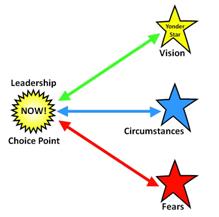Creating Shared Vision Is More Powerful Than Negotiation

During our recent leadership workshop for young indigenous leaders in Peru, we heard many opportunities for creating Shared Vision versus the types of things that usually come up when groups are trying to resolve issues like, “some things are non-negotiable,” “fighting for,” or “giving in and losing.”
Throughout much of indigenous history, (including recent experience), negotiating with the rich and powerful meant losing all or part of what you had, depending on how well you negotiated. Given this history, it is easy to decide the only solution is to take a “non-negotiable” stand, refuse to engage, or start fighting. While it seems like these are the only choices for self-protection, the tactics often failed and had serious consequences, (including death).
 The alternative we explored in the workshop was to search for common interests and desires and looking “up and out” for a higher “Yonder Star,” (our term for Shared Vision), that could include all parties’ goals. While there are no guarantees, this approach sets up a more open search for common interests and mutually beneficial solutions. Applying our Leadership Choice Point model, this is moving the conversation from the “Blue Line” representing the existing circumstances to the “Green Line” where Shared Vision is the context.
The alternative we explored in the workshop was to search for common interests and desires and looking “up and out” for a higher “Yonder Star,” (our term for Shared Vision), that could include all parties’ goals. While there are no guarantees, this approach sets up a more open search for common interests and mutually beneficial solutions. Applying our Leadership Choice Point model, this is moving the conversation from the “Blue Line” representing the existing circumstances to the “Green Line” where Shared Vision is the context.
The process of negotiating to avoid loss of what you have generally takes the conversation down to the “Red Line” where fear rules and people are operating from their reptilian brains as they engage, meaning fight, flight, freeze or appease responses are the only options and dialogues become monologues.
One of the participants shared a story of a big argument that went on over how to reduce maternal mortality in indigenous villages. The medical community had its solution that it insisted become regulation while the indigenous representatives insisted their traditional approaches and values were not being respected. Starting from the common interest of reducing maternal mortality, she and her team created a Yonder Star that included both perspectives and the situation was resolved to everyone’s satisfaction.
As a leader can you move from negotiating who gets the bigger piece of the “current pie” to higher ground that focuses on interests and goals that all parties share? Can you develop your skill at searching for this common ground and creating a Shared Yonder Star with all parties involved?
When you and your team focus on your Yonder Star, you are creating possibility and the solution set gets larger as you work with it. When you focus on worries and fears (red line on the leadership model), the problem always gets harder.
Building commitment to the Shared Vision dramatically increases both the possible solutions and the velocity of producing those solutions. In the words of W. A. Murray of the Scottish Himalayan Expedition in 1951, “Until one is committed, there is hesitancy, the chance to draw back, always ineffectiveness. Concerning all acts of initiative, (and creation), there is one elementary truth the ignorance of which kills countless ideas and splendid plans: that the moment one definitely commits oneself, then Providence moves too. All sorts of things occur to help one that would never otherwise have occurred. A whole stream of events issues from the decision, raising in one’s favor all manner of unforeseen incidents and meetings and material assistance which no man could have dreamed would have come his way.”
Featured Image Credit: https://www.flickr.com/photos/familymwr/
Category: Leadership
Tags: Leadership, Shared Vision

